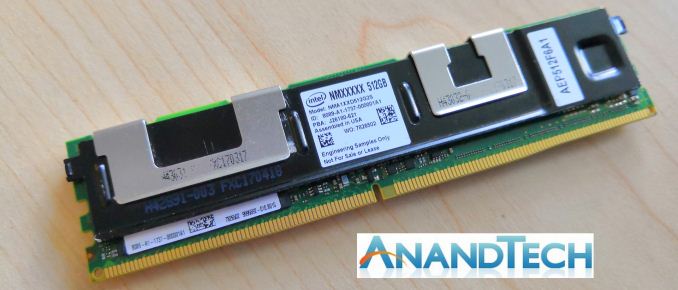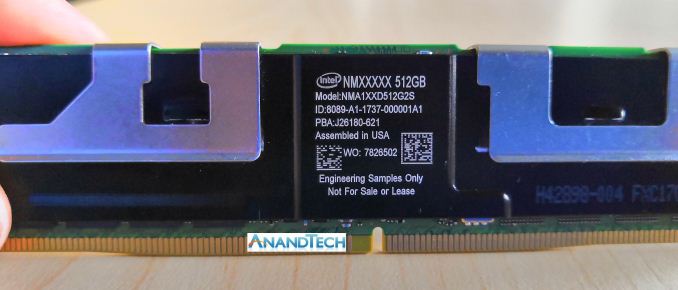Intel To Align 3rd Generation Optane DCPMM with DDR5: R&D in New Mexico
by Ian Cutress on April 10, 2019 1:00 PM EST- Posted in
- Memory
- Intel
- Optane
- Cascade Lake
- Optane DIMMs
- Optane DCPMM
- DDR4-T

At Intel’s Data-Centric Innovation Day, Intel clarified with us where it sits in relation to its Optane DC Persistent Memory Strategy.
While Intel made official launches for its new Cascade Lake Xeon Scalable platform with Optane DC Persistent Memory, we had a few meetings later that day to discuss the trending topics of the morning. One of those meetings was with Alper Ilkbahar, VP & GM of Intel’s Data Center Memory and Storage, who clarified parts of Intel’s roadmap on Optane DCPMM. With the technology being one of the key product differentiators on Intel’s side, it was key important to understand what the situation was with the technology.
As we previously reported, Intel and Micron are going their separate ways with regards to the 3D XPoint technology endeavor. Borne out of the IMFT joint venture between the two companies, the technology has been manufactured at the IMFT plant in Lehi, Utah, with each side getting half of the product off of the manufacturing line. In early 2018, the two companies decided to end their NAND partnership, with each company doing their own R&D into the third generation technologies. On the back of that, Micron had the rights to buy its stake in the JV, which includes the fab making the memory, and Micron announced at the end of 2018 its intension to exercise that right, which should have been completed on January 1st, 2019. As part of that deal, Intel hands over complete control of the fab to Micron, but still has access to its manufacturing facilities for another twelve months. After that, either Intel has to create a supply agreement with the fab, or manufacture its own.
In our discussions with Intel, the company confirmed that it would be equipping one of its facilities in New Mexico to enable research and development of its third generation Optane memory. The timescale of this was not discussed, nor was the intended manufacturing location. Intel clarified that it would only state that R&D was in New Mexico - if manufacturing were to happen there, the only fab Intel operates there is Fab 11X in Rio Rancho. That fab was planned to be upgraded to enable additional 14nm capacity as well as help bring up 10nm during 2020/2021, and Intel would not clarify if manufacturing would happen there - just R&D.
Also discussed was the form that Optane will take. Intel discussed that it was committed for Optane in a memory module form factor, and that it will be compatible with DDR5. That wasn’t to rule out third generation Optane for DDR4, but that third generation Optane will be the first to be pin-compatible with DDR5. Ultimately, the controller on the DIMM has to support the standard, rather than the memory, but Intel specified that this will be the inflection point.
If one were to extrapolate, and pair new Optane generations with Intel’s enterprise CPU roadmap, this might equate to 10nm Ice Lake having second generation Optane, given as it is DDR4, and a newer generation (perhaps Sapphire Rapids?) supporting both third generation Optane and DDR5. However these are conscious extrapolations into unknown areas of Intel’s roadmap, and should be taken as educated guesses. It all depends on how fast Intel decides to spin up its fab in New Mexico for Optane, and future generations of Optane.
We also encouraged Intel to talk about how newer generations of Optane will grow. One of the key factors in the first generation Optane is that at high performance, the memory modules hit a limit with regards the DIMM specification, with each DIMM rated to 18W. In order to improve capacity or performance, Intel is going to have to make great strides with efficiency, or build an enhanced connector for the technology. Given that Intel is committed to DDR5 for third generation Optane, the latter is unlikely to happen. The easiest way to improve power efficiency would be to support Optane on a smaller process node, but also other areas in memory and power management will be important as well. Intel clarified that they aim to improve future generation Optane on as many fronts as possible.
When asked, Intel also postulated the idea of perhaps providing off-roadmap versions of Optane in the future. While currently it is not in the plans, depending on the customer, Intel may look into special versions of Optane for a big client, for either performance or capacity.
Related Reading
- Intel's Enterprise Extravaganza 2019 Roundup
- Intel Xeon Scalable Cascade Lake: Now with Optane!
- Intel Agilex: 10nm FPGAs with PCIe 5.0, DDR5, and CXL
- Intel Columbiaville: 800 Series Ethernet at 100G, with ADQ and DDP
- Intel Launches the Xeon D-1600 Family: Upgrades to Xeon D-1500
- Lenovo’s New Cascade Lake ThinkSystem Servers: Up to 8 Sockets with Optane
- Dell PowerEdge Updates: Upgrade to Cascade Lake and Optane
- Supermicro Calvinballs Into Cascade Lake: Over 100 New and Updated Offerings












25 Comments
View All Comments
p1esk - Wednesday, April 10, 2019 - link
I think it will just say 512GB of Optane memory, and DDRX memory will be treated as L4 cache.HStewart - Thursday, April 11, 2019 - link
That is not true - see link belowp1esk - Thursday, April 11, 2019 - link
What's not true? I'm talking about Optane DIMM memory. If the laptop has it, then it would make most sense to use it as main system memory, with DDRX memory serving as cache.HStewart - Friday, April 12, 2019 - link
All I saying is that Optane memory can be use just as RAM on system, I expect it not a good idea to use it by itself - but in conjunction with normal DDR ram. From what I read this is one of modes that it can be setup to use. I not sure how important for laptop to have 512G of system memory, but an enterprise server run sql database would. I could see it being used in 3D application with large scene. I personally notice that with 16G of ram that with large scenes that 3d application slows down.imaskar - Friday, July 12, 2019 - link
Don't bother waiting for this in a notebook. Not for next 3 years at least. This is pure datacenter for now.MrPoletski - Monday, July 22, 2019 - link
I'm more interested in what this could mean for phones and other mobile devices. when your RAM is persistent, you will end up using a lot less power. I can see this unifying storage and RAM into one conglomerate blob. Can you say a phone with 128gig of RAM? Not only that, you would never need to 'boot' your device, because you just turn the CPU off and it's ram stays where it is.Mikewind Dale - Wednesday, April 10, 2019 - link
If it's DDR5 compatible, does that mean that *any* DDR5-compliant CPU+motherboard will support Optane DIMMs?This would be very cool because in my work (academic economist), most of my data analysis consumes about 16 GB, so I have 32 GB of RAM, but some of my colleagues have occasionally needed more than 32 GB. One of my colleagues recently started working with a 200 GB dataset, so she's been trying to figure out a way to avoid hitting the pagefile.
It would be cool if instead of getting 256 GB of RAM, a person could get 32 GB of DRAM plus a 256 GB Optane DIMM. In the meantime, I suggested she buy a 256 GB Optane SSD and set it as the location for her Windows pagefile.
IntelUser2000 - Wednesday, April 10, 2019 - link
Short answer: YesLong answer: You still need the controller to support Optane DIMM. But bringing Optane to be more compliant with DDR5 would mean that more platforms can support it.
The scenario you suggested with using 256GB Optane SSD as a pagefile is not that new. Their datacenter P4800X Optane SSDs have a software you can buy from them called Memory Drive which allows using your SSD to extend memory.
Mikewind Dale - Wednesday, April 10, 2019 - link
I didn't know about the Memory Drive software! I'll tell my colleague about that. Thanks!IntelUser2000 - Thursday, April 11, 2019 - link
Mikewind Dale: You are welcome.My opinion is that the Optane DC PMMs can effectively displace P4800X, because the price/GB of the modules are roughly equivalent to the P4800X when you add the Memory Drive(the software seems to add about $500).
The lowest Xeon Scalable chip that supports the Optane PMMs is the Xeon Silver 4215. All the Gold and Platinum models support it. Not sure if the P4800X with the Memory Drive feature will be worth it for the price, so do a fact check.
If you can get the 2nd generation system that supports the Optane PMMs, it'll be much better. For the price of 750GB P4800X with Memory Drive, you can get 6x 128GB modules that'll have 5-10x the bandwidth and 1/4 to 1/2 the latency, and that's in block storage mode where no changes are required. In Memory expansion mode and App Direct mode(this requires application support) the latencies go down even more.